 Somnath Temple Jyotirlinga is situated at Somnath Patan (the south coast of Saurashtra), near Veraval in (Prabhas Kshetra) Kathaiwad district in Gujarat. Somnath is considered to be the first of the 12 Jyotirlingas of Shiva and is a revered pilgrimage center in India.
Somnath Temple Jyotirlinga is situated at Somnath Patan (the south coast of Saurashtra), near Veraval in (Prabhas Kshetra) Kathaiwad district in Gujarat. Somnath is considered to be the first of the 12 Jyotirlingas of Shiva and is a revered pilgrimage center in India.Legend of Somnath Temple
Skanda Purana, in a chapter on Prabhasa Khanda, describes the emergence of this Jyotirlinga. Legend goes that the moon was married to the 27 daughters of Daksha Prajapati. Amongst all his wives, he had special love towards Rohini and neglected the others. Seeing the negligence of Chandra towards his other wives Prajapati Daksha cursed Chandra that he would lose his beauty and radiance. But because of a moon devoid of radiance and beauty the entire world became lifeless. A disturbed Chandra, came down to Prabhasa with Rohini and worshipped the Sparsa Linga of Somnath after which he was blessed by Shiva to grow and shine in the bright half. As the moon regained his light here, this town came to be known as Prabhasa. Brahma, one of the trinity, installed the Brahmashila, and paved way for the construction of the temple. On the request of the Chandrama and other gods Bhagwan Shankar assumed the name Somchandra (Jyotirlinga) and resided there eternally. He became famous by the name Somnath in the three worlds. Since, it was the Prabhas Kshetra where Bhagwan Shri Krishna performed all his Lilas. In this temple there is a small cave in which a lamp burns continuously.
The Skanda Purana describes the Sparsa Linga of Somnath as one bright as the sun, the size of an egg, lodged underground. The Mahabharata also refers to the Prabhasa Kshetra and the legend of the moon worshipping Shiva.
Ransacking and Rebuilding of Somnath Jyotirlinga
Somnath Jyotirling has been destroyed and rebuilt a number of times in the history:
- Accounts of glory and wealth of Somnath by the Arab traveler Al Biruni prompted a visit by Mahmud of Ghazini who ransacked and destroyed the temple in 1025 CE. It was immediately rebuilt by King Bhima of Gujarat and King Bhoja of Malwa.
- Somnath temple was destroyed again by Alaf Khan, the general of Allauddin Khilji in 1300 CE. It was rebuilt again by King Mahipala of the Chudasama dynasty.
- Somnath shrine was destroyed yet again in 1390, 1490, 1530 and finally in 1701 by Aurangazeb. It was rebuilt with perseverance each time after it was destroyed.




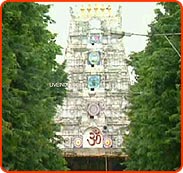 Mallikarjun Temple is situated on Shri Shaila Mountain by the banks of the Patal Ganga, Krishna River in the southern state of Andhra Pradesh. Also known as Kailash of the South, Mallikarjuna constitutes one of the 12 Jyotirlingam shrines of Shiva and is one of the greatest Shaivaite shrines in India. The presiding deities of Mallikarjuna Temple are Mallikarjuna (Shiva) and Bhramaramba (Devi). Every year there is a fair organized on account of Mahashivratri.
Mallikarjun Temple is situated on Shri Shaila Mountain by the banks of the Patal Ganga, Krishna River in the southern state of Andhra Pradesh. Also known as Kailash of the South, Mallikarjuna constitutes one of the 12 Jyotirlingam shrines of Shiva and is one of the greatest Shaivaite shrines in India. The presiding deities of Mallikarjuna Temple are Mallikarjuna (Shiva) and Bhramaramba (Devi). Every year there is a fair organized on account of Mahashivratri. Mahakaleshwara Temple is located by the banks of river Kshipra, in the dense Mahakal forests in Ujjain, Madhya Pradesh. It is an important Shaivaite pilgrimage centre in North India and is revered as one of the 12 Jyotilinga manifestations of Shiva.
Mahakaleshwara Temple is located by the banks of river Kshipra, in the dense Mahakal forests in Ujjain, Madhya Pradesh. It is an important Shaivaite pilgrimage centre in North India and is revered as one of the 12 Jyotilinga manifestations of Shiva. Omkareshwar Temple is situated on the mountain Mandhata by the banks of Narmada River in the Malva area in Madhya Pradesh. Omkareshwar Temple is one of the 12 revered Jyotirlinga shrines of Shiva. The temple is closely linked with Mammaleshwar Temple (situated on the south of river Narmada) as both the forms of Shiva have been counted as one.
Omkareshwar Temple is situated on the mountain Mandhata by the banks of Narmada River in the Malva area in Madhya Pradesh. Omkareshwar Temple is one of the 12 revered Jyotirlinga shrines of Shiva. The temple is closely linked with Mammaleshwar Temple (situated on the south of river Narmada) as both the forms of Shiva have been counted as one. Vaidyanath Temple, also called Vaijnath Temple and Baidyanth Temple is located at Deoghar in the Santhal Parganas region of Bihar in the south west of Keeul Station. Baidyanath shrine is revered as one of the twelve Jyotirlingams of Shiva. It may be noted that some schools of thought believe Vaidyanath near Parali in Andhra Pradesh to be the Vaidyanatha Jyotirlingam.
Vaidyanath Temple, also called Vaijnath Temple and Baidyanth Temple is located at Deoghar in the Santhal Parganas region of Bihar in the south west of Keeul Station. Baidyanath shrine is revered as one of the twelve Jyotirlingams of Shiva. It may be noted that some schools of thought believe Vaidyanath near Parali in Andhra Pradesh to be the Vaidyanatha Jyotirlingam. Rameshwaram Temple is situated in the island of Rameswaram, off the Sethu coast of Tamil Nadu and is reached via the Pamban Bridge across the sea. The huge temple is known for its long ornate corridors, towers and 36 theerthams.
Rameshwaram Temple is situated in the island of Rameswaram, off the Sethu coast of Tamil Nadu and is reached via the Pamban Bridge across the sea. The huge temple is known for its long ornate corridors, towers and 36 theerthams.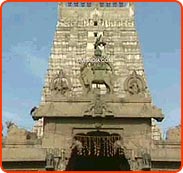 Nageshwar Temple or Nagnath Temple is located on the route between Gomati Dwarka and the Bait Dwarka Island on the coast of Saurashtra in Gujarat. The Jyotirlinga enshrined in the Temple of Nagnath is known as Nageshwar Mahadev and attracts thousands of pilgrims all round the year. This powerful Jyotirlinga symbolizes protection from all poisons. It is said that those who pray to the Nageshwar Linga become free of poison. The Rudra Samhita sloka refers to Nageshwar with the phrase 'Daarukaavane Naagesham'.
Nageshwar Temple or Nagnath Temple is located on the route between Gomati Dwarka and the Bait Dwarka Island on the coast of Saurashtra in Gujarat. The Jyotirlinga enshrined in the Temple of Nagnath is known as Nageshwar Mahadev and attracts thousands of pilgrims all round the year. This powerful Jyotirlinga symbolizes protection from all poisons. It is said that those who pray to the Nageshwar Linga become free of poison. The Rudra Samhita sloka refers to Nageshwar with the phrase 'Daarukaavane Naagesham'.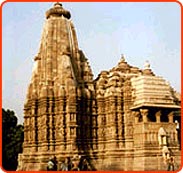 Vishwanath Temple is located amidst the crowded lanes in the holy city of Varanasi also known as Kashi and Benares. The Vishwanath Temple enshrines one of the twelve Jyotirlingams of Lord Shiva and is one of the most revered pilgrimage sites for Hindus. It is believed that Varanasi is the point at which the first Jyotirlinga, the fiery pillar of light by which Shiva manifested his supremacy over other gods, broke through the earth’s crust and flared towards the heavens. More than the Ghats and even the Ganga, the Shivalinga installed in the temple remain the devotional focus of Varanasi. Millions of pilgrims converge here to perform an abhishekam to the sacred Jyotirlingam with sacred water of river Ganga.
Vishwanath Temple is located amidst the crowded lanes in the holy city of Varanasi also known as Kashi and Benares. The Vishwanath Temple enshrines one of the twelve Jyotirlingams of Lord Shiva and is one of the most revered pilgrimage sites for Hindus. It is believed that Varanasi is the point at which the first Jyotirlinga, the fiery pillar of light by which Shiva manifested his supremacy over other gods, broke through the earth’s crust and flared towards the heavens. More than the Ghats and even the Ganga, the Shivalinga installed in the temple remain the devotional focus of Varanasi. Millions of pilgrims converge here to perform an abhishekam to the sacred Jyotirlingam with sacred water of river Ganga.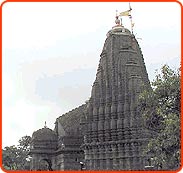 Shri Trimbakeshwar Temple is located at a distance of about 30-km from Nasik in Maharashtra near the mountain named Brahmagiri from which the river Godavari flows. Trimbakeshwar Temple is revered as one of the 12 Jyotirlinga shrines of Shiva and as the source of the river Godavari. Just as Ganga is known as Bhagirathi and is one of the most important river in North India, in the same way, Godavari is also known as Gautami Ganga and is the most sacred river in South India.
Shri Trimbakeshwar Temple is located at a distance of about 30-km from Nasik in Maharashtra near the mountain named Brahmagiri from which the river Godavari flows. Trimbakeshwar Temple is revered as one of the 12 Jyotirlinga shrines of Shiva and as the source of the river Godavari. Just as Ganga is known as Bhagirathi and is one of the most important river in North India, in the same way, Godavari is also known as Gautami Ganga and is the most sacred river in South India. One of the holiest pilgrimages for the Hindus, Kedarnath Temple Jyotirlinga is located in the picturesque surroundings of Rudra Himalaya Range at a height of 12000 feet on a mountain named Kedar. Near Kedarnath is the source of the river Mandakini that joins Alakananda at Rudraprayag. This place is approximately 150 miles away from Hardwar and 132 miles north of Hrishikesh and is accessible by foot.
One of the holiest pilgrimages for the Hindus, Kedarnath Temple Jyotirlinga is located in the picturesque surroundings of Rudra Himalaya Range at a height of 12000 feet on a mountain named Kedar. Near Kedarnath is the source of the river Mandakini that joins Alakananda at Rudraprayag. This place is approximately 150 miles away from Hardwar and 132 miles north of Hrishikesh and is accessible by foot.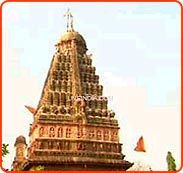 Grishneshwar Temple is an ancient pilgrimage site revered as the abode of one of the 12 Jyotirlinga manifestation of Lord Shiva. The Grishneshwar Jyotirlinga shrine is located at a village called Verul, which lies 20 km from Daulatabad (near Aurangabad in Maharashtra) and approximately 100 kms from Manmad station. Located close to Daulatabad (once known as Devagiri) is the popular tourist attractions Ajanta - Ellora.
Grishneshwar Temple is an ancient pilgrimage site revered as the abode of one of the 12 Jyotirlinga manifestation of Lord Shiva. The Grishneshwar Jyotirlinga shrine is located at a village called Verul, which lies 20 km from Daulatabad (near Aurangabad in Maharashtra) and approximately 100 kms from Manmad station. Located close to Daulatabad (once known as Devagiri) is the popular tourist attractions Ajanta - Ellora.





















